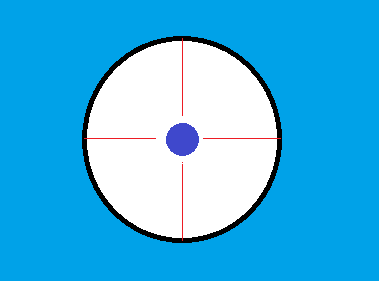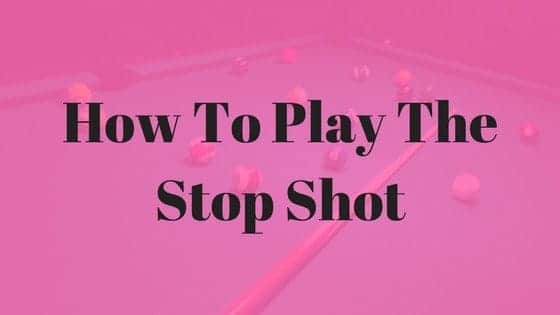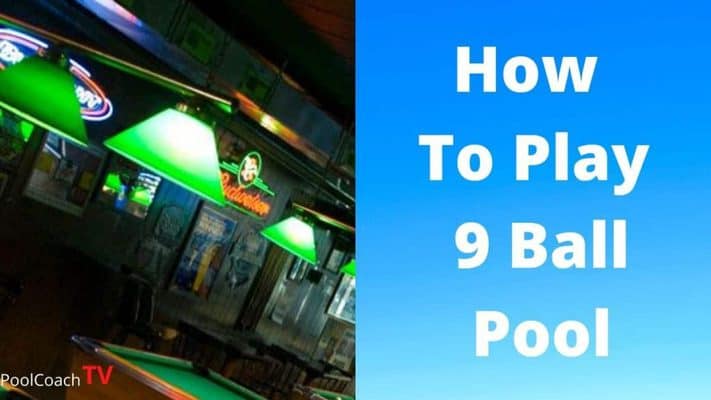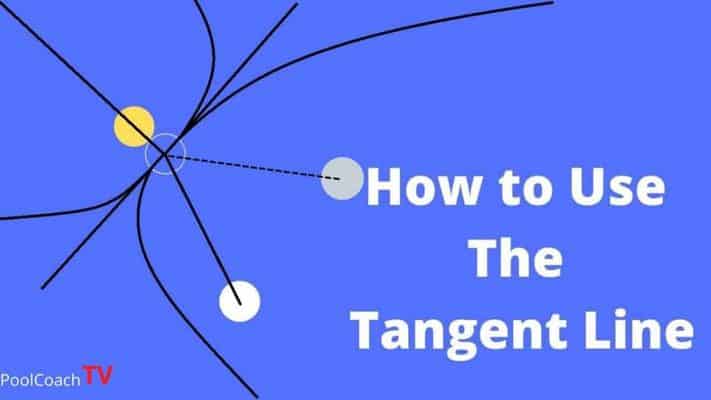If you find out how to play the stop shot in pool you will quickly move your game on to the next level. Knowing the stop shot will make using the tangent line easier and lead to better position shot all around.
If you were hoping for this to be some kind of fantastic trick shot you’re going to be disappointed it’s probably the simplest shot to perform on a pool table period.
However, to play the stop shot well every time requires a great deal of effort and repetitive practice.
Simple is not always easy.
I am of course talking about the stop shot or the stun shot as it’s known in some places. This is the shot where the white ball stops on contact with the object ball.
What is a Stop Shot in Pool?
The stop shot happens when the cue ball strikes the object ball during a straight in shot with no further movement of the cue ball either forward or backward or side to side.
The ball stops dead.
This is because the white ball is skidding along the cloth with no spin in any direction.
When you strike the cue ball below center it initially spins backward. However, this spin eventually wears off due to friction, next the ball skids for a while, then it picks up forward rotation due to friction.
This Shot Is Also called:
- The stun shot
- The Kill Shot
It really doesn’t matter what you call the stop shot so long as we are on the same page.
In snooker, it is known as the stun shot but in USA pool halls I hear the stop shot being used more often.
I have included a video below…
Why Do We Need The Stop Shot?
It is the main building block for great position play. It is the starting point for game improvement once you have mastered the basics.
If you want to know where your cue ball is going you need to learn how to stop the cue ball.
Once you can stop the cue ball without further movement on a straight shot, you can progress onto shots with an angle.
Tip Position For The Shot.

This tip position will change depending on the ball location, pace and distance.
So for a long distance stop shot you will need to adjust your cue power and the tip position or a combination of both.
The shot may need to be stroked at medium pace with 2 tips below center tip position to stop the ball. Playing the shot at a lower speed, with a lower tip position may have the same result.
How you play the shot will depend on your preference.
You Need To Find Your Own Stop Shot!
Play straight in shots at different distances and speeds until you get a feel for your own personal stop shot.
Your personal stop shot will be different to other players. Your feel for the shot and your tip position will be learned by repeating the shots over and over. Mix up your tip position and power to find the many combinations that give the same result.
How to Find Your Stop Shot.
Every player can achieve the stop or stun shot but each player will use a slightly different technique. Results are the same but the method is different.
Here is a list of factors that can change the end result of the stop shot:
- The distance between the balls.
- Vary the power of the stroke.
- Longer or shorter follow through.
- The pressure of the grip.
- Positioning of the tip on the cue ball.
All of the above affect the outcome of the shot.
It is not enough to pick out a spot on the cue ball, for instance, “just below center.”
In other words if there is 8 feet between the balls, you will need to lower the tip impact point on the ball, increase power of the stroke or use a mixture of both to ensure that the cue ball is skidding.
The Skid Zone, Distance and Timing.
A ball is said to be skidding when it is sliding along the cloth and not spinning either forward or back. When a ball is skidding along the cloth it is being slowed down by friction from the cloth. This friction will eventually cause the ball to start turning in the direction of its initial travel.
With regard to distance the white ball when hit with zero spin will initially skid on the cloth and then pick up forward spin due to friction. The white will only stop on impact if it reaches its target whilst it is still skidding. Its forward momentum is halted by the object ball and because ti has no spin the ball will stop dead on impact.
Conversely when the ball is struck below center it will spin backwards. After a while it will stop spinning and skid along the cloth. Further distance will result on forward spin as friction comes into play
Greater distance between the balls will call for a lower hit on the cue ball or more speed to achieve the same effect.
How Many Ways Can the Stop Shot be Played?
In fact, how many ways can any shot be played?
With only:
- 3 tip positions
- 3 distances
- 3 power levels
We have 27 shot variables (Of course there are really thousands.)
But not all of them will work for a stop shot so you have to experiment until you find the right ones for you.
| Shot # | Shot Power (Low/Medium/High) | Tip Position (Low/Medium/High) | Distance (Short/Medium/Long) |
| 1 | Low | Low | Short |
| 2 | Low | Low | Medium |
| 3 | Low | Low | Long |
| 4 | Low | Medium | Short |
| 5 | Low | Medium | Medium |
| 6 | Low | Medium | Long |
| 7 | Low | High | Short |
| 8 | Low | High | Medium |
| 9 | Low | High | Long |
| 10 | Medium | Low | Short |
| 11 | Medium | Low | Medium |
| 12 | Medium | Low | Long |
| 13 | Medium | Medium | Short |
| 14 | Medium | Medium | Medium |
| 15 | Medium | Medium | Long |
| 16 | Medium | High | Short |
| 17 | Medium | High | Medium |
| 18 | Medium | High | Long |
| 19 | High | Low | Short |
| 20 | High | Low | Medium |
| 21 | High | Low | Long |
| 22 | High | Medium | Short |
| 23 | High | Medium | Medium |
| 24 | High | Medium | Long |
| 25 | High | High | Short |
| 26 | High | High | Medium |
| 27 | High | High | Long |
Can you work out the shots that will actually result in the cue ball stopping?
Look through the list to find one that you think will work and then try it out on the table. You really need to have fun with this type of shot until you can adjust the variables without thinking.
You have to experiment, its part of the journey.
Now Comes the Magic.
If you play an angled shot with the same stroke as you would if you were trying to stop the ball, you will ensure that the cue ball travels down the tangent line.
So now you will be playing a “stop shot” but at an angle instead of straight. The force of the shot will now be split between the cue ball and object ball depending on the shot angle.
In other words, hit the cue ball with the same tip placement and power as you would for a straight shot but this time on an angle shot.
Why is the Stop Shot So Important for Position Play?
The tangent line is a predictable repeatable 90 degree angle. So if you know how to send your white down the tangent line every time you have a solid baseline shot on which to build all of your other positional shots.
What do I mean by this?
When you look at a shot, quickly gauge the angle of the cue ball after contact.
Where will the ball go if it follows the tangent line?
Will that particular direction help you or not?
This narrows down the number of choices available to you and simplifies the decision process.



